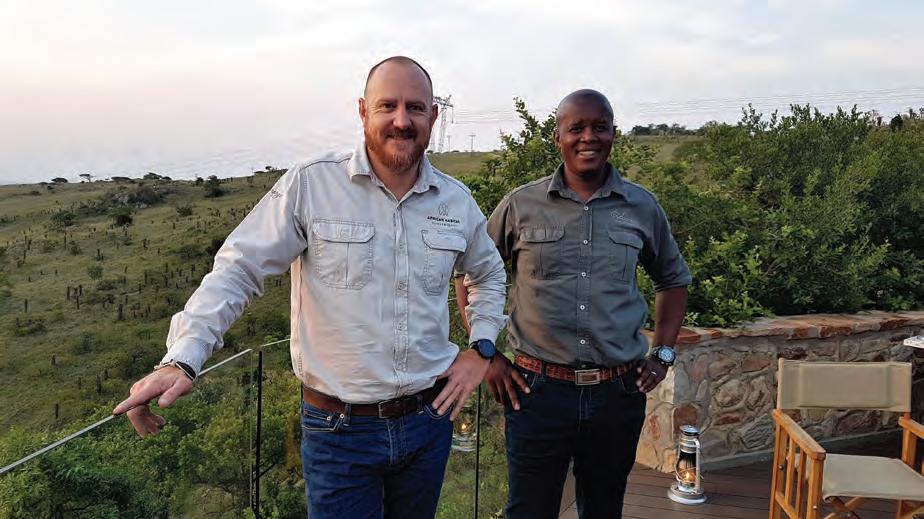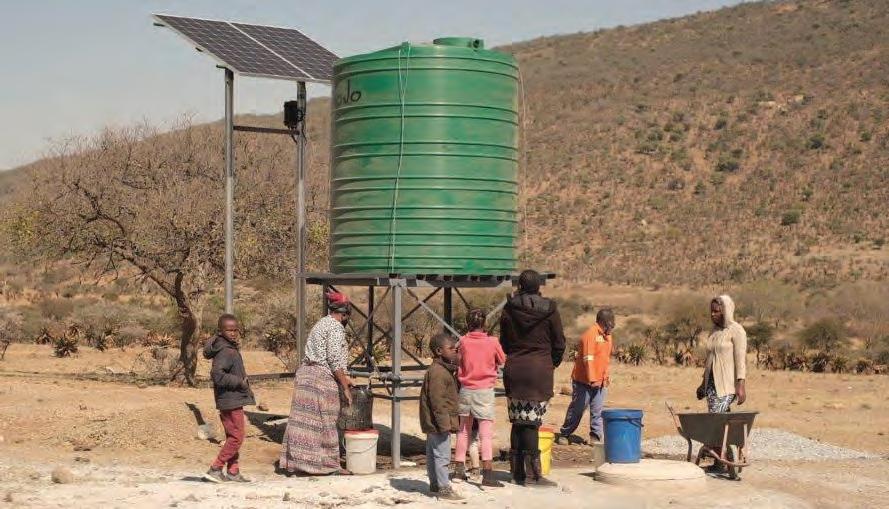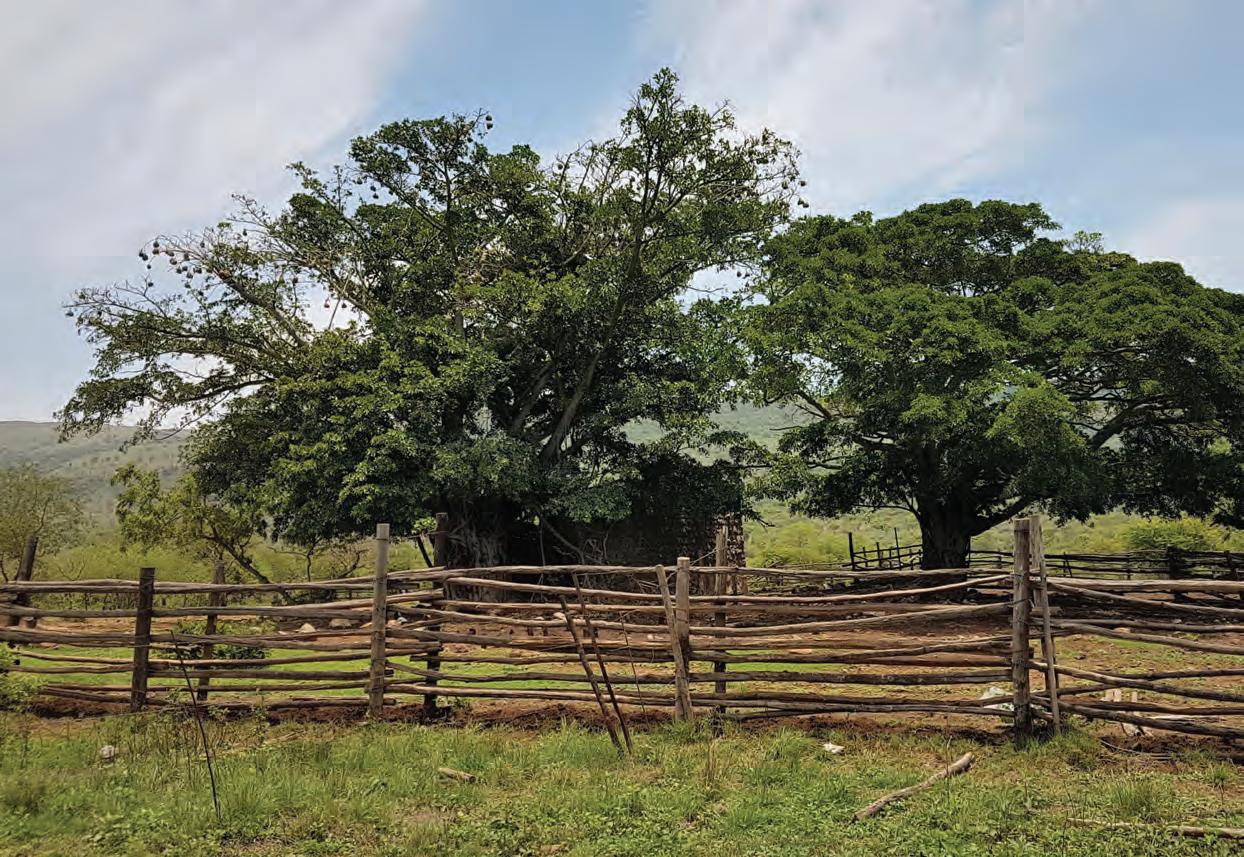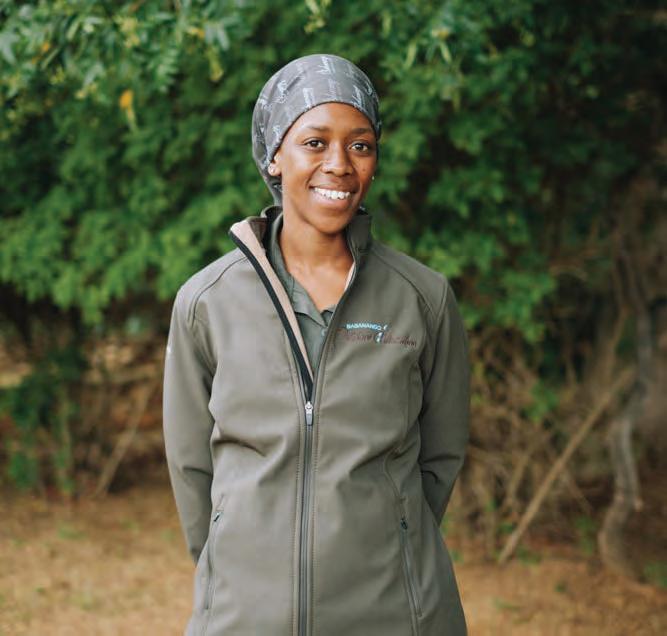
9 minute read
a working relationship that yields a win for all
CONSERVATION & COMMUNITY
a working relationship that yields a win for all
Advertisement
words - Tessa Buhrmann pics - Tessa Buhrmann / African Habitat Foundation
The view is compelling, as is the conversation. I’m sitting on the deck at Zulu Rock, one of the lodges within Babanango Game Reserve (BGR), chatting to COO Jeffrey van Staden to get to the nitty-gritty of what’s involved in the setting up a conservationcommunity partnership as is the case with BGR and its surrounding communities.
“It’s an investment that’s been four years in the making, and one that realises the Emcakwini community’s decade-long dream of sourcing the right partners to help restore economies to this region,” explains Jeff.
It’s a process that began with the establishment of the African Habitat Conservancy, (AHC), by German philanthropist Hellmuth Weisser and Jeff himself as a vehicle to support conservation of African wildlife in central KwaZuluNatal through investment and community development. Unbeknown to them at the time, the Emcakwini community had been looking to partner with the private sector to develop land that they had obtained through land claims. A quest that led to a ‘being in the right place at the right time’ moment when the community and AHC made contact.
The land concerned was just 50Km from the town of Vryheid in the northern reaches of KwaZulu-Natal, a malaria-free wilderness area that two hundred years ago was the stamping ground of the King Shaka himself, and whose impis once roamed the regions hills and valleys.
Some of the land had previously been utilised as hunting farms, some for livestock and another as a small game reserve – but all were now either over-grazed or almost devoid of wildlife and in desperate need of conservation. But the 22 000-hectares of grasslands, thornveld and riverine thicket, that also included a 23Km stretch of the White uMfolozi River, had the potential to become something quite outstanding.
Jeff tells me that when originally presented with the feasibility study and financial model for Babanango Game Reserve, AHC quickly recognised the impact on the region’s biodiversity that investment would make, especially for the local communities in the area. Babanango Game Reserve thus became AHC’s first project - one that’s already seeing impressive results.
The establishment of the BGR realises local Emcakwini, Esibongweni and KwaNgono community’s decade-long vision of creating a wilderness area that would attract tourism and stimulate the local economy. Added to that AHC is working to address the lack of education, training, employment, and entrepreneurial opportunities through the funding of selected projects such as schools, infrastructure, agricultural initiatives, and other ventures that give back to the community.
“We’ve committed to funding programmes to enable skills development in all aspects of conservation, reserve management and tourism/hospitality that will both create career opportunities while at the same time inspiring the greater community to further their prospects.” explains Jeff.
The opportunities in this respect are equally exciting, with many new ‘spin-off’ businesses and procurement opportunities in the pipeline. Ideas the AHCF is working on include a shuttle service providing staff

Jeff van Staden & Musa Mbatha




transportation, a refuse removal company and the growing of fresh produce for use in the lodges.
In line with AHC’s commitment to the community they have started the African Habitat Foundation (AHCF) headed by the very capable and experienced Kudzai Mqingwana. Jeff tells me that AHCF’s vision is to encourage people to empower themselves by working hard and establishing their own small enterprises.
He tells me that the support of entrepreneurship that Kudzai brings to the community is pivotal to the foundation’s work. And “that by helping groups of people start businesses we are encouraging the community to support themselves”. In Kudzai’s words, “looking to the future, the AHC Foundation’s most important gift to our community is the support of our schools, our infrastructure and awarding education bursaries, but people are already seeing tangible benefits, and that tells

us we are doing something great, that’s changing people’s lives and helping them to value the land we are protecting.”
Thus far, the development of Babanango has created 110 new jobs, 90 of which have been filled by local people, with another 150 new, permanent posts set to be filled by members of the Emcakwini community. “We remain optimistic that the work being done by the AHCF will help to position our community as a South African success story and will demonstrate how working together to protect our natural heritage can help to drive economies in communities such as ours,” says Jeff.
The AHC’s commitment to conservation and communities is evident, but what about the nitty-gritty, the tough conversations and feet-on-the-ground hard work that was required, I wondered. A day or so later at Babanango Valley Lodge I manage to pin down Babanango Reserve Manager, Musa Mbatha for a frank conversation.
He tells me that he is a local through and through, that he was born in the area and grew up here. That as a young boy he used to hunt duiker with his dogs, and that that this was his only knowledge of wildlife before applying for a job as a guard at a nearby privately owned game reserve. Fast forward ten years, much learning, several wildlife qualifications, and much experience later he found himself with the opportunity of working for the African Habitat Conservancy and the newly founded Babanango Game Reserve as their Reserve Manager.
He laughs, telling me that as there was no game yet, he had to do something, and that something was community engagement, which involved telling them about the game reserve and how it would benefit them. “The people grazed their cattle here, they were collecting grass in here, collecting firewood… I remember engaging them was very difficult, with a lot of push back.”
“I went to the aMakhosi first, the traditional leaders, to introduce the project to them so that I could get buy in, and then the aMakhosi’s took it down to the iNdunas, and then from the iNdunas it filtered down to the community” Musa tells me.
He emphasises the importance of this, that by doing it the right way BGR was respecting the culture of the people. Some of the aMakhosi’s bought into the idea from the start as they could see the benefit to the area, some were more reluctant and took a bit longer.
Musa tells me that in this area there are no jobs for people, people are unemployed, and life is difficult, with most people living from Government grants. “I knew that this would make a change for people, that it would make a difference in their lives.
They see me, my life has changed through working in this field. I am an example to them, because when I started, I had nothing and look where I am now” he says. “To them I am a living testimony… from walking on foot, to driving a skoroskoro (a worn and ragged) car, now I am married with a family and have built my own house’.
I’m beginning to realise that this was no easy endeavour… and that by having someone local, with a history that local community members could relate to was making all the difference.
I learn that in addition to the community leadership, there are the community members themselves to deal with. Some were easier to convince, like those that were in need with no jobs at all, so the promise of employment opportunities made them easy.
Then there were those that were able to sustain themselves from income sent home by someone working in one of the cities, they were doing ok, but the extra money earned from employment would be great, so they were relatively easy too.
The difficult ones Musa told me were the small-business people, the cattle farmers, ‘we’ve got cattle’ they said, ‘we don’t need the game reserve’ they said, and ‘we’ve been living without you all this time’. He explains that to counter this they needed to invest in them because “to get them out we had to offer them a better alternative,
to give them a better reason to leave than to stay. Which is what we’re doing now through the African Habitat Foundation”.
Some of these projects include creating fenced camps for their cattle, making sure the areas have water and that the quality of the grazing is good. Generally, the community are happy with the fences because currently the cattle can go wherever they want to, “even all the way to Ulundi”, Musa tells me, “which is 60km away, so being fenced stops them from wandering as well as from potential stock theft.”
In addition to this they are helping people with veterinary services for their cattle, and are introducing ‘Meat Naturally’ to them, a project that is creating a market for community raised cattle. This means that they get a better price for their cattle with a lesser cost to get them to market.
This was where I realised that it takes time, persistence and an innate understanding of local traditions and culture to get the job done. And with just a few more kilometres of perimeter fencing still to go, and the fenced in cattle areas complete it won’t be long before the community’s dream will be realised.
I was fortunate enough to have a conversation with Eric Buthelezi, chairman of the Emcakwini Community Trust, just before leaving BGR. He reiterates much of what both Jeff and Musa have been telling me, emphasising the difficulty of finding employment in Babanango especially with much of the community unskilled and with little to no employment opportunities. I ask him about the community sentiment now with the jobs that have been created, the entrepreneurship opportunities available and the secure areas for the farmers to graze their cattle.
“In this early stage there’s a huge difference, so everyone is very happy and already living a much better life than before,” Mr Buthelezi tells me, “it has been a bit faster than we expected and it has made a huge impact already with both the employed and unemployed now happy. It’s the first time in Babanango that we’ve seen just one employer employing so many people. So even those that are unemployed, they still believe that their opportunity is coming.”

As we drive past aloe-clad hillsides, rocky slopes and swathes of grassland I marvel at the biodiversity of Babanango Game Reserve and continue my conversation with Jeff, which veers back to that of sustainability and conservation. He tells me about the Biodiversity Economy in South Africa, a Presidential Priority Project supported by President Ramaphosa. I learn that there are 11 biodiversity economy nodes in South Africa of which only two are active, both being in KwaZulu-Natal and in the uMfolosi economy node – one of which is Babanango Game Reserve.
“Within the country, in terms of conservation promoting the Biodiversity Economy we are way ahead” Jeff tells me, “and that really means putting wildlife in the ownership of local communities.”
And that, is Babanango Game Reserve in a nutshell – conservation and communities, and an amazing tourism experience to boot.
www.babanango.co.za www.africanhabitat.org












